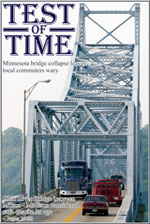



Test of Time
Minnesota
bridge collapse
leaves local commuters wary
Ohio
River Bridge in Milton considered safe,
officials say, but effort continues
to
fund construction of a new one
By
Konnie McCollum
Staff Writer
(September 2007) – Twice a day, five days a week
for 23 years, Madison, Ind., resident Duane Cieslinski has crossed the
Ohio River Bridge connecting Madison to Milton, Ky. Cieslinski commutes
to Carrollton, Ky., where he works as a senior engineering specialist
at Dow Corning Corp.
 |
|
2007
September |
While he realizes the nearly 80-year-old bridge has some
problems to deal with, he eventually became immune to the idea of the
bridge collapsing.
That changed, however, when news of the horrific rush-hour collapse
of the I-35W Bridge in Minneapolis on Aug. 1 spread throughout the nation.
Thirteen people were killed and numerous hurt during the catastrophe.
“The Minneapolis bridge tragedy made me worry about some of the
issues our bridge faces,” Cieslinski said. “It really makes
you wonder how secure the integrity of the structure is.”
He is not alone in that thought. Communities across the nation are taking
a serious look at their own bridges in the aftermath of the Minnesota
tragedy. Media scrutiny has recently increased on the aging bridge infrastructure
throughout the country.
The Ohio River Bridge was built in 1928-1929 by the J.G. White Engineering
Co. of New York City at a cost of $1,365 million. It is the only bridge
across the Ohio River from Louisville, Ky., to the Markland Dam and
Locks Bridge in Vevay, Ind. The bridge is 3,181 feet in length, with
three 150-foot steel deck truss spans; one 150-foot through truss steel
span; one 254-foot through truss steel span; one 727-foot through truss
steel span; two 600-foot through truss steel spans and one 78-foot steel
plate girder span. The piers and abutments are concrete, and the floor
is concrete. The bridge has two 10-foot lanes.
 |
|
Photo by Konnie McCollum "If
the officials say it |
The Minneapolis I-35W Bridge was built in the 1967 and
was a steel deck truss bridge. In the 1990s, the federal government
gave the bridge a rating of “structurally deficient,” citing
significant corrosion in its bearings. There are 77,000 bridges throughout
the United States with that designation, including the one in Milton.
A structurally deficient designation does not imply a bridge is in imminent
danger of collapsing. It does, however, mean attention needs to be paid
to problems.
Maintenance of the bridge in Milton since 1937 has been under the direction
of the Kentucky Transportation Department. To determine the safety of
a bridge, Kentucky Transportation officials conduct a series of inspections,
including a yearly inspection, and an underwater inspection every four
to five years and a fracture critical inspection every other year. Recent
inspections have deemed the bridge not only structurally deficient but
“functionally obsolete” as well. That simply means that a
bridge does not meet current design standards for things such as the
width of lanes. Anyone who has driven across the bridge can attest to
the narrowness of the lanes.
Dylan Ehrnreiter, 25, lives in Milton but has driven to Madison for
nine years to work. While he acknowledges he has felt the bridge shake
on occasion, he doesn’t really worry too much about it falling.
He does, however, have concerns about how narrow the bridge is.
“When I pull my band equipment in a trailer behind my pickup truck,
I get nervous because my wheels stick out a bit. I am not used to it
and the narrowness of the lanes does concern me.”
The bridge also received a sufficiency rating of 31.5 out of a possible
100 points. Before a 1997 refurbishing, the rating was 21.6.
Andrea Clifford, public information office for the Kentucky Transportation
Cabinet, Louisville, District, explained the rating is calculated by
a formula based on about 20 different factors. These factors are divided
into three categories: structural adequacy and safety; serviceability
and functional obsolescence and essentially for public use.
The structural adequacy and safety category includes the superstructure,
substructure and culverts. The serviceability category includes such
factors as the number of lanes on the structure, the structure type,
deck condition, underclearances and waterway adequacy. The essentially
category includes the factors of average daily traffic and the detour
length if the bridge were not in service.
In 1997, the bridge went through a $12 million rehabilitation project,
and at that point Kentucky Transportation officials removed a 31-ton
weight limit imposed on the bridge. The rehabilitation is supposed to
be good until 2012, the year work on a replacement bridge is scheduled
to begin.
 |
|
Photo by Don Ward The
Ohio River Bridge connecting Milton |
Although a $4.5 million contract has been let for environmental
impact and design, work has not yet started. Madison Mayor Al Huntington
believes a 2017 replacement date would be more realistic. By the time
a replacement bridge is open for business, the age of the current bridge
will be narrowing in on the century mark.
Huntington recently called for a ban on semi-trucks using the bridge.
In a letter to Kentucky Transportation Cabinet Secretary Bill Nighbert,
he stated, “In order to preclude a catastrophic bridge collapse
resulting in human loss of life, and to safely extend the life of this
region’s single most important transportation link, the Milton-Madison
Bridge must be weight limited to include only automobiles and small
trucks.”
Huntington said he is not trying to paint a gloom and doom picture;
instead, he is trying to paint a bright picture for the future.
“We want to stretch the life of the bridge until the replacement
one is completed,” he said. “We can’t afford to loose
the bridge, and we certainly don’t want to loose people should
the bridge go down.”
He said during the 1997 rehabilitation, commerce in Madison dropped
sharply. “We realized at that point how vital Kentucky business
is to our community. Some of that business we lost forever.”
Carla Goins, a coordinator for gifted students at Trimble County Middle
School, travels to Trimble County from Madison, where she resides. Recently,
a group of her students used research about the bridge they gathered
for a unique competition sponsored by the U.S. Army. Her students compiled
official records and research on the bridge and concluded it had some
serious safety concerns and needed to be replaced. They presented their
findings to officials on both sides of the river in a push to bring
the issue of a replacement bridge back into the political limelight.
“I just felt sick when I heard about the Minneapolis tragedy,”
said Goins. I kept thinking about the condition of our bridge and how
I would react to such a thing in our community.”
 |
|
Carla Goins |
She said there are times when she gets nervous crossing
the bridge, particularly when there are heavy trucks on it. She believes
a weight limit on the aging structure would be the “responsible
and sensible thing to do” until the new bridge is built.
“I really don’t know why the weight limit was lifted in the
first place,” she said. “We learned that the two things that
bring down bridges are corrosion and weight, and we certainly have both
of those issues for our bridge.”
According to Clifford, the weight limit was deemed unnecessary after
the 1997 refurbishing. “If at some point officials deem a weight
limit necessary, they will put limits in place.”
Many truck drivers feel the same way, including Allen Webster, a dispatcher
for Madison’s M&M Towing. Webster drove semi trucks back and
forth across the bridge for 26 years. Some of the semis he has driven
have weighed up to 80,000 pounds, but he does not worry when he is crossing
the bridge in one. “If the officials have said it is safe for trucks,
then I believe it,” he said. “I’ve certainly driven across
much worse.”
He acknowledges the narrow lanes and the entry ways to the bridge create
problems for truck drivers, particularly the entrance to the bridge
on the Indiana side. “You just have to pay close attention to what
you are doing,” he said.
He questioned the recent calls for a ban on trucks on the bridge. “Why
did the government spend $12 million on repairing the bridge if it didn’t
work; instead, they should have put that money toward building a new
one.”
Webster pointed out that if truckers were required to travel to the
Markland Dam or Louisville to cross the Ohio River, consumers would
end up paying for the extra costs in fuel and time.
 |
|
Randy Stevens |
Columbus Container trucks can be seen crossing the bridge
quite frequently. Fleet Maintenance Director Richard Wallman said the
weight issues don’t concern his trucks because they don’t
have to scale their cargo. “We transport corrugated cardboard,
so our trucks are not really that heavy.”
He said he would be somewhat concerned if his trucks carried heavier
loads. “It would be something to certainly think about,” he
said.
His concerns lie more with the narrowness of the lanes. His company,
based in Columbus, Ind., had to purchase 96-inch wide trailers to use
on the bridge and other narrow roads throughout the region. They use
102-inch wide trailers to transport elsewhere.
Although weight and width issues have been the focus of recent attention,
the age of the structure concerns others. “In my experience, the
life expectancy is usually 30 to 40 years in the design of things,”
said Cieslinski. “The bridge has certainly surpassed that expectation.”
Goins’ students pointed out that when the bridge was built, it
was designed for Ford Model A Cars, which are now considered “antiques.”
The Minneapolis bridge that collapsed was 40 years younger than the
Ohio River Bridge in Milton. In fact, a bridge many consider the “sister”
of the local bridge, the Silver Bridge in Point Pleasant, W.V., collapsed
in 1967. In that tragedy, 46 people died and nine were seriously injured.
The Silver Bridge and Milton’s bridge, which are often compared
because they were constructed at about the same time, do not have the
same design. The Silver Bridge was an eyebar suspension bridge.
 |
|
Duane Cieslinski |
Trimble County Judge-Executive Randy Stevens said he does
have concerns about the aging structure but doesn’t think there
is need for alarm. “Although the bridge is not designed for its
current use, I hope there is no imminent danger of collapse. I can’t
imagine dealing with a catastrophe like that.”
He said there is an upside to the bridge issues, including that fact
that every elected official in the communities affected by the bridge
are “in total agreement about the need for bridge replacement.”
He stressed how important that bridge is for the communities that depend
on it. “The workers who travel the bridge, and trade and commerce
on both sides need it.”
He also sees the money let for the environment and design study as encouraging,
but he cautions that officials need to keep moving forward to secure
the additional money for right-of-ways, land and other pre-construction
issues.
“This is the No. 1 infrastructure project in our region,”
he said. “If Madison and Jefferson County, Ind., and Trimble County
had the means to start the replacement bridge, we would already done
it.”